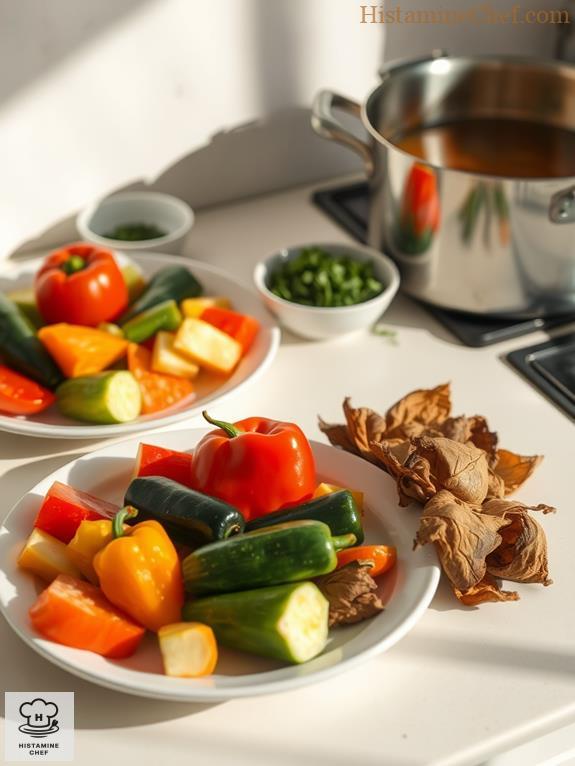Ever wondered why that aged cheese makes you feel funky? Let me spill the beans on histamines.
I’ve been on a wild ride with histamine intolerance. Fresh foods are my BFFs now. They’re like little superheroes for my gut.
As food ages, bacteria throw a party and crank up the histamine levels. Not cool for sensitive stomachs like mine.
I’ve learned to embrace the farmer’s market life. Blueberries, apples, and other fresh goodies keep my tummy happy.
Want to join the low-histamine club? Grab that SIGHI list and let’s make some killer meals together!
My Histamine Horror Story: When Aged Cheese Attacked
Picture this: me, a cheese board, and a bottle of wine. Sounds dreamy, right? Wrong.
One bite of that fancy aged Gouda, and boom – hives city! My face looked like a connect-the-dots puzzle gone wrong.
That’s when I knew: histamines and I were frenemies. Since then, I’ve become a fresh food fanatic.
No more funky ferments for this gal. It’s all about that crisp produce life now.
Who knew adulting would involve reading bacterial cultures like gossip mags?
Understanding Histamine in Foods

Understanding histamine in foods can be quite complex, especially if you’re managing dietary restrictions. It’s like playing food detective—exciting but tricky! Histamine is a naturally occurring compound in the body, but its levels can vary greatly in foods, making it essential to know which ones to avoid.
When I first learned about histamine reactions, my head spun. I found out that certain foods, like aged cheeses and processed meats, could trigger sensitivity. Yikes!
So, I turned to the SIGHI list for guidance. You won’t believe how many fruits and vegetables are safe! Apples, blueberries, and carrots are my heroes.
Histamine related disorders can also affect your food choices. But be careful! Even the freshest foods can cause issues if you’re not paying attention.
Fresh Foods and Histamine Levels

Fresh Foods and Histamine Levels
Steering through fresh foods and their histamine levels can feel overwhelming at times, but it’s essential for managing sensitivities. Understanding how to read food labels for hidden histamines is vital.
When I shop for fresh produce, I look for freshness indicators, like vibrant colors and crisp textures. Spoilage signs, such as wilting or browning, are my red flags!
Food storage plays a huge role in nutrient preservation, too. Keep your veggies cool and dry to maintain lower histamine levels. Did you know that some fresh foods, like apples and blueberries, are low-histamine heroes?
Mastering food labels can help you make informed choices when selecting fresh items. Following dietary guidelines like the SIGHI list helps me make better choices.
Keep in mind, fresh is best! And hey, we all deserve delicious meals without the worry. That’s why I started the Histamine Chef blog—to share these tasty insights!
The Aging Process Explained

As we age, our bodies change in a lot of ways, including how we handle histamine. This means that the foods we once enjoyed may begin to have different effects on our bodies over time.
You might be wondering why that matters when it comes to food safety, right? Well, I’m excited to share how histamine formation mechanisms can impact what we eat and why some foods might start to feel a little less friendly as we add candles to our birthday cakes!
Freshness preservation strategies can play a significant role in how we manage our food choices.
Histamine Formation Mechanisms
Histamine formation in food is a fascinating yet complex process that can greatly impact our health, especially as we age.
When we talk about histamine synthesis, it’s all about how bacteria in our food microbiology break down proteins. These little critters can turn amino acids into histamine, especially in aged foods like cheese and fermented products.
Ever wondered why that old cheese smells a bit funky? Yep, that’s the histamine doing its thing!
While fresh foods like apples and rice are usually safe, aged options can pack a histamine punch. So, keeping an eye on your diet is essential. Trust me, your tummy will thank you!
I share these insights on my blog, Histamine Chef, to help you navigate food safely and deliciously.
Impact on Food Safety
Aging food presents significant implications for food safety, particularly concerning histamine levels. As I explore this topic, I can’t help but think about how proper food preservation techniques can keep us safe.
You see, microbial growth and spoilage factors can skyrocket if we don’t store food correctly. Using safe storage methods and temperature control is essential for extending shelf life.
Have you ever opened a package of aged cheese? Yum, right? But if it’s not stored properly, it can be a histamine bomb!
Utilizing effective packaging techniques can help keep those pesky histamines at bay. So, always check the SIGHI list before exploring those delicious snacks.
Keep in mind, safety first—your taste buds will thank you later!
Comparisons of Fresh Vs Aged

Often, fresh foods are more favorable when it comes to histamine levels compared to their aged counterparts.
Have you ever bitten into a crisp apple or snapped a fresh green bean? That freshness can mean lower histamine levels! Aging effects can lead to higher histamine sensitivity, especially for those with dietary restrictions.
When we talk about food storage, it’s essential to look for freshness indicators like color and texture.
Nutritional changes occur with aging, too. Spoilage indicators can make that once-delicious flavor develop into something less appetizing.
Cooking Tips for Low Histamine

When it comes to preparing meals, choosing the right cooking methods can greatly impact histamine levels in your food. For instance, using fresh ingredients and employing smart cooking techniques can help maintain low histamine content while enhancing flavor.
For meal prep, I love keeping things fresh—opt for pure, fresh meats and vegetables from the SIGHI list. Try ingredient swaps like using coconut milk instead of dairy for creaminess without the histamine hassle! Additionally, smart cooking techniques can further optimize your meals for low histamine.
When it comes to cooking techniques, steaming or grilling is often best.
And don’t forget about food storage; fresh ingredients are your friends! For flavor enhancement, use spice alternatives like fresh herbs instead of dried ones.
Recipe modifications can add variety—think of delightful snack ideas like fresh fruits instead of the restricted ones.
Choosing Foods for Your Diet

When it comes to choosing foods for my diet, I always check the SIGHI list to figure out what’s allowed and what’s restricted. I mean, who wants a surprise histamine reaction while enjoying a tasty meal, right?
Fresh foods are the way to go—they’re not just good for my health, but they also make my dishes pop with colors and flavors that I can’t resist!
Plus, there are delicious low-histamine alternatives for fermented foods that can help me enjoy similar tastes without the histamine load low-histamine options for fermentation.
Allowed vs. Restricted Foods
Maneuvering the world of allowed versus restricted foods can feel overwhelming, especially if you’re trying to manage histamine levels in your diet.
But don’t worry, I’ve got your back!
Here’s a quick guide to get you started:
- Allowed Vegetables: Most veggies are good to go! Just avoid the restricted ones like spinach and tomatoes.
- Restricted Fruits: Say goodbye to bananas and strawberries. They can be tricky!
- Allowed Starches: Quinoa and rice are great choices.
- Restricted Dairy: Watch out for aged cheeses; they can pack a histamine punch!
Fresh Food Benefits
Choosing fresh foods can greatly impact your health, especially when managing histamine levels. When I fill my plate with vibrant fruits and veggies, I can’t help but feel energized!
Fresh foods offer incredible nutritional advantages, from essential vitamins to antioxidants that fight off free radicals. Plus, they’re lower in histamine, which is vital for those of us sensitive to it.
Think about the freshness importance—would you rather munch on a crisp apple or a mushy one? Freshness not only tastes better but also helps keep histamine levels in check.
By sticking to the SIGHI list, I can enjoy delicious meals without worry. So, let’s embrace fresh foods together!
What’s stopping you from diving into a colorful salad today?
FAQ
How Does Histamine Intolerance Vary Among Individuals?
Histamine intolerance varies widely among individuals due to genetic factors, dietary influences, and gut health. I’ve noticed symptom triggers differ, making it essential to understand my unique responses and adapt accordingly for safety.
Can Freezing Foods Reduce Histamine Levels?
I’ve found that freezing effectiveness can help manage histamine stability in foods. While it might not eliminate histamine completely, it can slow down its buildup, making it safer for those with histamine intolerance.
Are There Supplements That Help Manage Histamine Levels?
I know it may seem challenging, but I’ve found that certain supplements, especially probiotics, can support histamine management. They offer benefits even within dietary restrictions, promoting gut health and overall safety in my choices.
Does Cooking Method Affect Histamine Levels in Foods?
I’ve noticed that cooking techniques can influence histamine levels. Combining safe food pairings and using gentle methods, like steaming or boiling, helps me enjoy meals while keeping my histamine reactions in check. Safety’s my priority.
What Common Symptoms Indicate Histamine Intolerance?
Visualize a garden where signs of distress appear; headaches, hives, or stomach issues could signal histamine intolerance. By identifying these symptoms, I pinpoint potential histamine sources, ensuring I cultivate a safe, thriving environment for my health.
Summary
I choose fresh foods to keep my histamine levels low. It’s like painting my plate with vibrant colors. Fresh ingredients breathe life into dishes, while aging can increase histamine content. On my blog, Histamine Chef, I guide readers through this journey.
Have you noticed differences in how you feel after eating fresh versus aged foods? Share your experiences in the comments below.
Help spread awareness about histamine intolerance by sharing this post on your social media. Your support helps Histamine Chef reach more people seeking information on managing their symptoms.


Leave a Reply